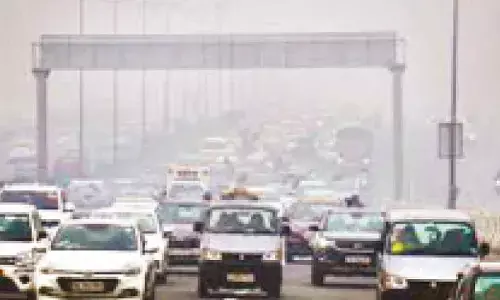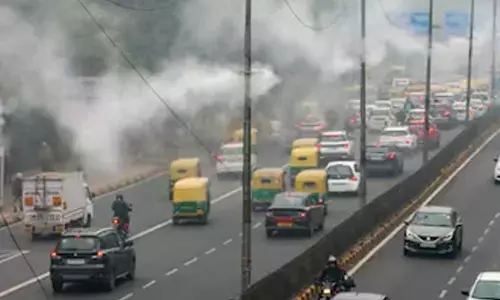Indus delta's ecosystem under threat
 Pakistan government’s indifference poses huge threat to human life and ecology, according to studies
Pakistan government’s indifference poses huge threat to human life and ecology, according to studies"What you don't see, you cannot feel." This phrase was used by Tanzeela Qambrani, Pakistan's first lawmaker of African descent, to encapsulate the plight of the impoverished communities living in the once-flourishing Indus delta. Qambrani, whose Sheedi community is concentrated in the coastal regions of Makran in Balochistan province and Sindh, said the level of poverty is "incredible".
Known as the vertebra of Pakistan's ecology and economy, the Indus delta is the fifth largest in the world and home to the seventh biggest mangrove forest. In recognition of its international importance, the wetland was designated as a Ramsar site in 2002. It forms where the mighty Indus river flows into the Arabian Sea, creating a complex system of swamps, streams and mangrove forests. A triangular piece of fertile land is created when the fast-flowing river deposits rich sediment as it empties into the sea.
However, dam construction and mismanagement of water by the government have significantly reduced river flows, causing the delta to shrink, and threatening both human life and its ecology. The absence of flowing freshwater allows seawater into the delta, destroying the soil and the aquifers, making it unfit for humans, animals or crops. For years, the communities in the delta have reported the loss of livelihood, an increase in disease and forced migration to cities which are already densely populated. "Almost everyone you know has tested positive for Hepatitis C," said Qambrani.
There are acres of land where nothing can grow, and people are forced to remain only because they do not have the resources to migrate. To understand the extent of their despondency, she said, Pakistan's Prime Minister Imran Khan must visit the delta himself. Yet, despite pleas from the communities and compelling recommendations made by experts in a first-of-its-kind study published in 2018, not much has changed. The study made some startling revelations. Among the most shocking discoveries is evidence that, over the last two centuries, the delta has shrunk by 92 percent.
Altaf Siyal, a professor at the Mehran University of Engineering and Technology (MUET) in Jamshoro which led the study, was its lead author. "When the delta was a flourishing ecosystem, it had 17 creeks," he told thethirdpole.net. "Today, there are just two active ones left." The evidence pointed to the following reasons: decreased river flow to the delta resulted in reduced sediment deposits; surface and subsurface seawater intrusion; land subsidence, sea level rise, climate change, and anthropogenic activities — all of which have contributed to the shrinkage and degradation of one of the largest ecosystems in the world.
As the glaciers of the Hindu Kush Himalayas —which make up 80 percent of the Indus flow — melt at a faster rate, there should be more water to sustain a sizable population in the short term, but in an increasingly unpredictable manner. However, detrimental policies and ill-informed projects have destroyed both the delta and the groundwater. Many experts feel that taming the mighty Indus through dams and barrages was perhaps the biggest mistake. Nasir Panhwar, an environmentalist and former coordinator for WWF's Indus for All Programme, said the reservoirs on the Indus and its tributaries were constructed to serve the needs of expanding agriculture as well as the subsequent industrial development.
He said that today the delta is starved of sediment because economic priorities overruled the ecological consequences that will haunt us for years to come. He blamed the severe degradation of the delta on the upstream diversions of the river. "It is one of the worst examples of human interventions in nature."
He warned that construction of more dams might result in "no flow", to the detriment of the delta. If electricity is needed, maybe run-of-the-river plants maybe considered, as they do not obstruct water as much. Still, he emphasised that wind and solar are better options, especially when both the resources are found in abundance. According to Siyal, deltas need to be kept alive as they are biologically the most "productive places" in the world, due to their rich biodiversity which provides shelter and a natural breeding ground to migratory birds and animals. In addition, he said they provide livelihood to millions of people both in and around the delta, especially those working in agriculture.
The construction of dams upstream, however, led to a decline in sediment which has translated to a massive loss in agriculture for the inhabitants of the Indus delta. Panwhar cited a 2019 World Bank study which noted that from an estimated 270 million tonnes per year at pre-development levels, the sediment that reaches the delta today is a mere 13 million tonnes.
The groundwater is as bad, if not worse. Evidence showed that up to 94% of groundwater samples had chloride concentration higher than the safe limit.
There is little understanding among the public or policymakers about why the flow of the river is important for the sea. "The delta is considered a wasteland. The release of freshwater from the Indus is also termed 'wastage'," said Panhwar. "It is imperative to educate and sensitise everyone about the significance of the Indus delta." If the delta fails to get fresh water from the Indus, Siyal said it may die. He shared the example of central Asia's Aral Sea which dramatically shrank because of the damming of the Syr Darya river upstream.
The report's lead author said that for surface seawater intrusion, the construction of dykes and levees is very important. He added that this was among the demands of the local communities in the delta as it will provide them quick and easy access to the markets of Karachi. Water resources expert, Hassan Abbas, however, said dykes interfere with tidal action necessary for mangrove forests and roads on dykes can block high floods from draining out to the sea, trapping the communities in un-drained floodplains for months to come.
"A coastal highway through the delta is a good idea as long as it does not interfere both with the tidal action as well as natural flood flows," he concluded. The study recommended the expansion of the 38 kilometre coastal highways to up to 200 kilometres in length. Some work had already started long before Siyal's report. Qambrani pointed to the 87 kilometre Sindh Coastal Highway terming it a "good initiative" but added it would take a decade to complete. Siyal further said there was field evidence that whenever levees were built in the delta, there was minimum surface seawater intrusion. He gave the example of the Netherlands, where levees have been built to protect seawater flooding.
Other recommendations included the promotion of biosaline agriculture; encouraging shrimp and crab farming in natural water bodies; imposing a ban on overgrazing and cutting of mangroves for wood; restoring dried up river channels like Ochito and Old Pinyari; ensuring water availability at the tail end of canals, such as Pinyari and Phuleli; and reviving saline lakes by adding freshwater.
But the most important thing, the study noted, is ensuring 8.6 million acre feet (MAF) of water flows annually below Kotri barrage as recommended by an international panel of experts. Sadly, almost three years since the report was made public, none of the recommendations has been taken up by the government. "We were approached by the Ministry of Planning Development and Special Initiatives a year back. They had seen our study and wanted to carry out a discussion with us on how to improve the delta conditions, but nothing concrete has happened based on the report so far," said Bakhshal Lashari, Project Director at the USPCAS-W.
Lawmaker Qambrani had not read or heard about Siyal's report. But as someone who hails from the coastal town of Badin, she was well aware of the issues of sea intrusion, waterlogging and salinity. "We have been crying ourselves hoarse to bring this to the notice of the federal and provincial governments. If they do not take the plight of the delta seriously, the map of Pakistan will change in the coming 50 years, when all of the delta will be submerged in the Arabian Sea."
(This article was first published on www.firstpost.com. Reprinted with their permission)




















